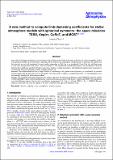Por favor, use este identificador para citar o enlazar a este item:
http://hdl.handle.net/10261/178502COMPARTIR / EXPORTAR:
 SHARE SHARE
 CORE
BASE CORE
BASE
|
|
| Visualizar otros formatos: MARC | Dublin Core | RDF | ORE | MODS | METS | DIDL | DATACITE | |

| Título: | A new method to compute limb-darkening coefficients for stellar atmosphere models with spherical symmetry: The space missions TESS, Kepler, CoRoT, and MOST |
Autor: | Claret dos Santos, Antonio CSIC ORCID | Palabras clave: | Stars: atmospheres Planetary systems Binaries: eclipsing |
Fecha de publicación: | 2018 | Editor: | EDP Sciences | Citación: | Astronomy and Astrophysics 618: A20 (2018) | Resumen: | Aims. One of the biggest problems we can encounter while dealing with the limb-darkening coefficients for stellar atmospheric models with spherical symmetry is the difficulty of adjusting both the limb and the central parts simultaneously. In particular, the regions near the drop-offs are not well reproduced for most models, depending on Teff, log g, or wavelength. Even if the law with four terms is used, these disagreements still persist. Here we introduce a new method that considerably improves the description of both the limb and the central parts and that will allow users to test models of stellar atmospheres with spherical symmetry more accurately in environments such as exoplanetary transits, eclipsing binaries, etc. Methods. The method introduced here is simple. Instead of considering all the μ points in the adjustment, as is traditional, we consider only the points until the drop-off (μcri) of each model. From this point, we impose a condition I(μ)=I(1) = 0. All calculations were performed by adopting the least-squares method. Results. The resulting coefficients using this new method reproduce the intensity distribution of the PHOENIX spherical models (COND and DRIFT) quite well for the photometric systems of the space missions TESS, Kepler, CoRoT, and MOST. The calculations cover the following ranges of local gravity and effective temperatures: 2.5 ≤ log g ≤ 6.0 and 1500 K ≤ T ≤ 12 000 K. The new spherical coefficients can easily be adapted to the most commonly used light curve synthesis codes.© 2018 The Author(s). | URI: | http://hdl.handle.net/10261/178502 | DOI: | 10.1051/0004-6361/201833060 | Identificadores: | doi: 10.1051/0004-6361/201833060 issn: 1432-0746 |
| Aparece en las colecciones: | (IAA) Artículos |
Ficheros en este ítem:
| Fichero | Descripción | Tamaño | Formato | |
|---|---|---|---|---|
| IAA_2018_aa33060-18.pdf | 313,74 kB | Adobe PDF |  Visualizar/Abrir |
CORE Recommender
SCOPUSTM
Citations
94
checked on 11-abr-2024
WEB OF SCIENCETM
Citations
99
checked on 29-feb-2024
Page view(s)
234
checked on 26-abr-2024
Download(s)
150
checked on 26-abr-2024
Google ScholarTM
Check
Altmetric
Altmetric
NOTA: Los ítems de Digital.CSIC están protegidos por copyright, con todos los derechos reservados, a menos que se indique lo contrario.
